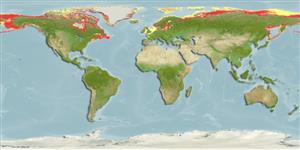分類 / Names
共通名の | 類義語 | Catalog of Fishes(部類, 種) | ITIS | CoL | WoRMS | Cloffa
>
Perciformes/Cottoidei (Sculpins) >
Cottidae (Sculpins)
Etymology: Myoxocephalus: Greek, myos = muscle, and also, mouse + Greek, kephale = head (Ref. 45335); quadricornis: From Lönnberg..
More on author: Linnaeus.
Issue
Some authors use the genus Triglopsis for this species. See the list of references in Eschmeyer (CofF ver. Sep. 2011: Ref. 88002). More studies are needed.
Environment: milieu / climate zone / depth range / distribution range
生態学
海; 新鮮な水; 汽水性の 底生の; 深さの範囲 0 - 100 m (Ref. 58496). Polar; 83°N - 41°N, 180°W - 180°E
Atlantic and Arctic: Baltic coast of Sweden, Finland, Russia and southwestern to eastern Poland; western coast of Sweden to northern coast of Norway, eastward to White and Barents Sea basins. In Siberia eastward to about Anadyr estuary. Landlocked populations in Sweden, central Finland and Karelia (Ref. 59043). Arctic drainages of North America (Ref. 5723).
Length at first maturity / サイズ / 重さ / 年齢
Maturity: Lm ? range ? - ? cm
Max length : 60.0 cm TL オス/雌雄の選別がない; (Ref. 2058); common length : 30.0 cm TL オス/雌雄の選別がない; (Ref. 2058); 最大公表体重: 260.00 g (Ref. 27547); 最大記録サイズ: 14 年 (Ref. 12193)
背面の脊椎 (合計): 7 - 9; 背鰭 (合計): 13-16; 肛門の骨 0; 臀鰭: 13 - 17; 脊つい: 37 - 42. Identified by the four bony protuberances on the top of the head (the protuberances are smaller in females and young and absent in the freshwater form), the chainlike lateral line, the sharp spines on the preoperculum, and the absence of palatine teeth (Ref. 27547). Gill rakers reduced to rounded, spiny protuberances (Ref. 27547). Soft dorsal often much enlarged in adult males; caudal truncate to slightly rounded (Ref. 27547). Young gray above, with three or four dark saddles below dorsal fins and a dark spot on dorsal side of caudal peduncle; adults are darker; spiny dorsal fin dusted with black; soft dorsal, anal, pectoral and caudal fins have dark bars; pelvic fins pale (Ref. 27547).
Occurs in cold brackish and moderately saline water near the coast (Ref. 27547). Enters coastal rivers and may occur as far as 120 miles inland (Ref. 5723). Landlocked in lakes (Ref. 59043). Maximum depth reported at 100m (Ref. 35388). Benthic (Ref. 58426). Movements are limited to short onshore-offshore seasonal movements and mass movements of fry into shallow water in autumn (Ref. 28908, 28910). Moreover, there are no migrations of large numbers; movement into freshwater and long distances up rivers are apparently undertaken by relatively few individuals at a time (Ref. 27547). Diurnal from November to April but is largely nocturnal the rest of the year (Ref. 28905). Feeds on small crustaceans, fishes (Ref. 4968) and molluscs (Ref. 58426). Spawning takes place in shallow waters, male digs a groove in the gravel where pairing and egg laying occur. Move to deeper water in the spring, where they stay in summer (Ref. 35388). Landlocked populations are locally threatened (Ref. 59043).
Life cycle and mating behavior
成熟 | 繁殖 | 放精 | 卵 | 生産力 | 幼生
Males become territorial and aggressive toward other males with the approach of the spawning season. Two or three days prior to spawning, the females become restless and swim about between short periods of rest. When a female swims over a male, he undulates his body from side to side and raises his spiny dorsal fin, If the female comes to rest near the male, he moves close to her in a series of short darts. Both then fan rhythymically with their pectoral fins, making a hole. The pair lie side by side, with the male's caudal fin twisted under that of the female. The male make rhythmic motions toward the female with his tail, and the motions apparently stimulate her to release her eggs (Ref. 28900, 28901). After spawning the female leaves the nest; the eggs are fanned and guarded by the male until hatching which occurs in the spring (Ref. 27547).
Robins, C.R., R.M. Bailey, C.E. Bond, J.R. Brooker, E.A. Lachner, R.N. Lea and W.B. Scott, 1991. Common and scientific names of fishes from the United States and Canada. Am. Fish. Soc. Spec. Publ. (20):183 p. (Ref. 3814)
Human uses
水産業: 食糧水産
より多くの情報
参考文献水産養殖水産養殖の紹介緊張遺伝子のElectrophoreses遺伝病気行列NutrientsMass conversion
用具
特記事項
XMLをダウンロードして下さい
インターネットの情報源
Estimates based on models
Preferred temperature (Ref.
123201): -1.8 - 4.3, mean -1 °C (based on 6042 cells).
Phylogenetic diversity index (Ref.
82804): PD
50 = 0.5000 [Uniqueness, from 0.5 = low to 2.0 = high].
Bayesian length-weight: a=0.00724 (0.00579 - 0.00906), b=3.14 (3.08 - 3.20), in cm total length, based on LWR estimates for this species (Ref.
93245).
栄養段階 (Ref.
69278): 3.9 ±0.62 se; based on food items.
回復力 (Ref.
120179): 低い, 4.5年~14年の倍増期間の最小個体群 (tm=3-5; tmax=14; Fec=792).
Fishing Vulnerability (Ref.
59153): Moderate vulnerability (44 of 100).
Nutrients (Ref.
124155): Calcium = 73.6 [14.2, 243.1] mg/100g; Iron = 0.358 [0.135, 1.153] mg/100g; Protein = 18.6 [15.8, 20.9] %; Omega3 = 0.493 [0.205, 1.367] g/100g; Selenium = 13.3 [5.5, 31.9] μg/100g; VitaminA = 9.77 [2.06, 48.14] μg/100g; Zinc = 0.784 [0.313, 1.423] mg/100g (wet weight);
